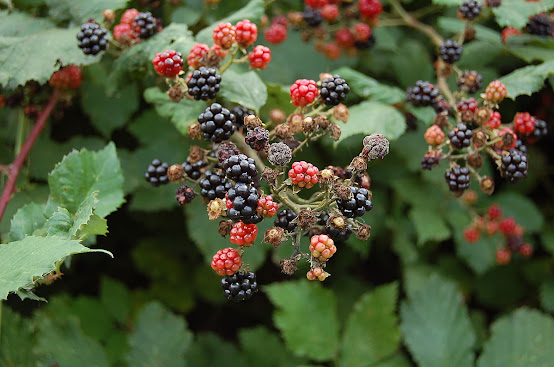The Himalayan Blackberry: An Unwelcome Intruder in Victoria, BC
Introduction:
The Himalayan blackberry, scientifically known as Rubus armeniacus, is a species of blackberry that has become a notorious part of the Pacific Northwest landscape. Introduced to North America as a food crop in the late 19th century, this plant has since spread far and wide beyond cultivation, becoming one of the region's most aggressive and damaging invasive species. While the berries may be delicious, the overall impact of this invasive plant on local ecosystems is far from sweet.
1. Rapid and Aggressive Growth:
The primary reason Himalayan blackberry is considered highly invasive is due to its rapid and aggressive growth. With canes that can grow up to 20 feet in length in just one season, the Himalayan blackberry quickly forms dense, impenetrable thickets that cover large areas of land. This rapid growth enables the plant to outcompete and effectively smother native vegetation, thereby disrupting local ecosystems.
2. Impact on Biodiversity:
By outcompeting native plants for resources, Himalayan blackberries can drastically reduce biodiversity. As they form dense thickets, they alter habitats and negatively impact the wildlife species that depend on native plants for survival. This effect on biodiversity extends beyond plant life, affecting a broad range of insects, birds, mammals, and the overall health of ecosystems.
3. Soil Erosion Risk:
While Himalayan blackberry’s dense root system might initially seem beneficial for soil stabilization, the plant's tendency to kill off other vegetation ultimately increases the risk of soil erosion. Once it establishes dominance, the understory becomes devoid of other plants whose roots could help to hold the soil in place, leaving areas more susceptible to erosion, particularly on slopes and along waterways.
4. Fire Hazard:
The thickets created by Himalayan blackberries can become fire hazards, particularly in the dry summer months. Old, dead canes and leaves accumulate within the thickets, creating a significant amount of dry, flammable material. These blackberry patches can serve as a ready fuel source for wildfires, and their dense structure can also hinder firefighting efforts.
5. Human Impact:
In addition to environmental concerns, Himalayan blackberries can have significant impacts on human activities. Their impenetrable thickets can block access to rivers, trails, and other recreational areas. Moreover, their sharp, thick thorns can cause injury and make infested areas difficult and dangerous to navigate or manage.
6. Economic Implications:
Himalayan blackberries can also have economic implications. They can lower property values and are costly to control or eradicate, posing a significant economic burden on public agencies, private landowners, and farmers.
Mitigation and Management:
Controlling and eradicating Himalayan blackberries requires substantial effort due to their vigorous growth and reproductive capabilities. Management strategies often include a combination of manual, mechanical, and chemical methods.
1. Manual Removal:
This method is often recommended for smaller infestations. It involves physically removing the plants, including their root balls, using garden tools like loppers, pruners, and shovels. The idea is to cut back the plants to ground level and then dig up the roots to prevent regrowth. Be sure to dispose of the cuttings appropriately, as blackberries can regrow from stem or root fragments.
While manual removal is labor-intensive and may need to be repeated several times to achieve complete eradication, it is environmentally friendly and poses no risk to surrounding plants and animals.
2. Mechanical Removal:
For larger infestations, mechanical removal using heavy equipment like a backhoe or brush cutter may be necessary. This approach can quickly clear large areas of blackberries. Like manual removal, this method involves cutting back the plants and then removing as much of the roots as possible. However, mechanical removal can disturb the soil significantly and may harm nearby desirable plants.
3. Herbicides:
Herbicides are another option for controlling Himalayan blackberries. Herbicides can be applied to the foliage, cut stumps, or canes of the plants.
When using herbicides, it's crucial to follow the manufacturer's instructions to ensure effective treatment and to minimize harm to non-target plants and the environment. Also, remember that timing is essential. Late summer to early fall is typically the best time to apply herbicides to blackberries, as this is when the plants are moving nutrients from their leaves to their roots for winter storage, increasing the effectiveness of the herbicide.
4. Biological Control:
Biological control involves using the plant's natural enemies - typically insects or diseases - to help control its growth. However, as of current day there were no known biological control agents for Himalayan blackberries.
5. Grazing:
Certain types of livestock, such as goats and sheep, will eat Himalayan blackberries and can be used to help control the plants. This method can be especially useful in areas that are difficult to reach with equipment or where the use of herbicides is not desirable.
6. Regular Monitoring and Follow-Up:
Regardless of the method used, regular monitoring and follow-up treatments will be necessary to ensure the complete eradication of Himalayan blackberries. It is important to watch for and promptly address any new growth, as the plants can quickly reestablish from any roots or stem fragments left behind.
By reclaiming your landscape from these invasive brambles, you'll be helping to protect your local ecosystem's biodiversity and health.
Expert Help:
Contact us for a Free Quote. We care intensely about the success of each project.
Fill out our contact form for a free in-person assessment: www.ascentyardcare.com/contact
Or contact us directly at 250-886-0338 and jake@ascentyardcare.com
To learn more about our services visit our website at www.ascentyardcare.com




Comments
Post a Comment